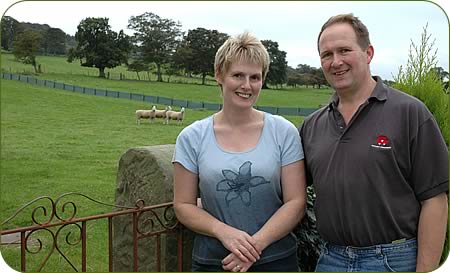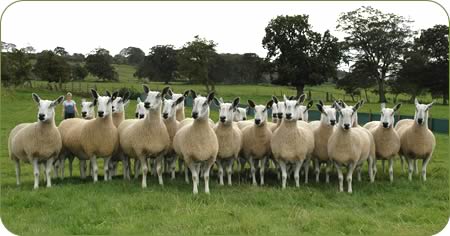 |
|||||||||
|
|||||||||||||||||||
| news index | Bluefaced Leicesters showing the way
One of the country’s oldest flocks of Bluefaced Leicesters has had probably its best year yet in the show and sale ring in 2004. The Cocklaw flock was started by Nicholas Robinson’s grandfather 101 years ago in Allendale later moving to West Cocklaw farm, Humshaugh, near Hexham where they own 200 acres and rent a further 120 acres plus 80 acres of grass park. Nicholas and his wife Kathryn run the flock with Nicholas’ parents Matt and Delores– with enthusiastic input from the couple’s daughter Amy, aged nine and son Nicky, six – alongside a pedigree 100-cow Friesian type dairy herd. The icing on the cake for the Robinsons was at this year’s Royal Highland Show in July when their two-crop home-bred ewe by a Pennine L1 sire achieved a first for the breed winning not only the breed and interbreed sheep championships but also collecting the Queen’s Cup, presented to the sheep section for the 2004 show, and the interbreed pairs. Then later in the month the ewe was in the winning group at the Bluefaced Leicester Sheep Breeders’ Association annual progeny show, staged for the first time at Penrith Agricultural Show where she was also the breed champion and reserve interbreed sheep champion.
At Kelso Ram Sales on September 10, the Robinsons had the top price for a Bluefaced Leicester at £3,500, although not their highest price to date, and topped the sale average for the breed with 20 rams selling for £1,267.50 – up on their average last year of £1,183 for 26 sold. Seven rams by the T1 Cocklaw ram which sold last year at Kelso for £3,800 the Robinsons retaining a half share with the Archers of Carry House, averaged £1,750 this year. A further three rams from an R3 ram shared with Robert Neil of Rossiebanks averaged £1,316 while another two by a Shirlew sire averaged £2,050. The top priced ram, now called The Gentleman, was bought by Hexhamshire breeder Alec Bisset, of Middle Dukesfield, in partnership with Andrew and David Kay, of Hartside Farms, Oxton. Three years ago at Kelso they achieved their best price yet - £5,200. Shearlings were also entered for the Carlisle and Hexham sales in October. A Pennine son, Cocklaw Class Act R4 sired the gimmers which won the Bluefaced Leicester progeny show at Welshpool and the individual championship at the same show went to a shearling ram sold at Kelso in 2003.
The Cocklaw flock has grown over the years from around 20 ewes to today’s 80 females to be able to select for top quality. The best ewes are retained as flock replacements and possibly half a dozen gimmers are sold with any sheep that do not come up to standard being culled. “If you can breed good looking ewes that comes through in the rams and we have produced good batches for the last two years,” said Nicholas Robinson. “The Pennine tup which we started using about seven years ago has done a lot of good in the flock, breeding most of the ewes currently in the flock along with another Old Parks sire. “We have always looked for tups that are very sharp and have good skins and legs. We are also very particular about the mouth which has got to be right for the tup to last. “We are looking to breed a sheep with size and width – the Pennine tup gave us this as well as body and good gigots to help the conformation of the Mule wether lambs.” Seventy per cent of the rams sold from the Cocklaw flock are used for North of England Mule lamb production. The Robinsons breed a few Mule lambs and buy some gimmers running up to 230 ewes which they then cross with the Texel and Suffolk and retain the ewe lambs. They also have a flock of 20 pure Suffolks and 50 Scotch Blackfaces. “We like the Bluefaced Leicester because they are a sheep which is full of character and very stylish. They have their own characteristics,” said Nicholas. Rams are all sold as shearlings, partly because of tradition and also because of competition for grazing with the dairy cows, so the Robinsons are able to lamb the Bluefaced Leicesters in March. Usually the Leicester flock is served naturally, although the Robinsons plan to use some AI this autumn. The Leicesters are housed overnight for a fortnight after lambing and the Mule ewes, depending on the weather, are kept inside for 24 to 48 hours and then turned out during the day and housed at night because of problems with foxes. The shearling rams which are sold are all wintered outside as hoggs following Matt Robinson’s philosophy ‘if they don’t live for us they won’t live for anybody’! The flock is not scanned but the ewes are all fed for twins – one of the breed’s advantages is its prolificacy. Both the pure ewes and the commercial flock are fed for two months while they are nursing lambs, receiving concentrates at both ends of the day. The sheep are run alongside the Friesian type pedigree dairy herd which has a rolling average yield of more than 7,000 litres at 4.26 per cent butterfat and 3.2 per cent protein, with a lot of heifers calved. Until recently, the dairy herd has been bred pure however a Limousin bull has been used on some of the cows this year. Between 30 and 40 bulls are finished each year on home-grown barley off up to 40 acres – the rest of the farm is grass. Prior to showing the Bluefaced Leicesters, the Robinsons exhibited their dairy cattle. Matt Robinson is also well-known for showing Clydesdale horses – he has three mares. And if the farming activities are not enough to keep the family busy, Kathryn Robinson and her sister in law Elsie Lambie have been running for the last three years from the farm a business called Suitability – hiring out men’s formal wear, from suits for weddings and dinners to kilts, ties, cummerbunds and waistcoats. © Copyright 2005 Jennifer MacKenzie All Rights Reserved. |
||||||||||||||||||

|
|
||||||||||||||||||
| home | agri-services | pedigree
pen | news | dairy | beef | machinery bps | property | organisations | site map |
|||||||||||||||||||

Article by
Jennifer MacKenzie
more Bluefaced Leicester links


